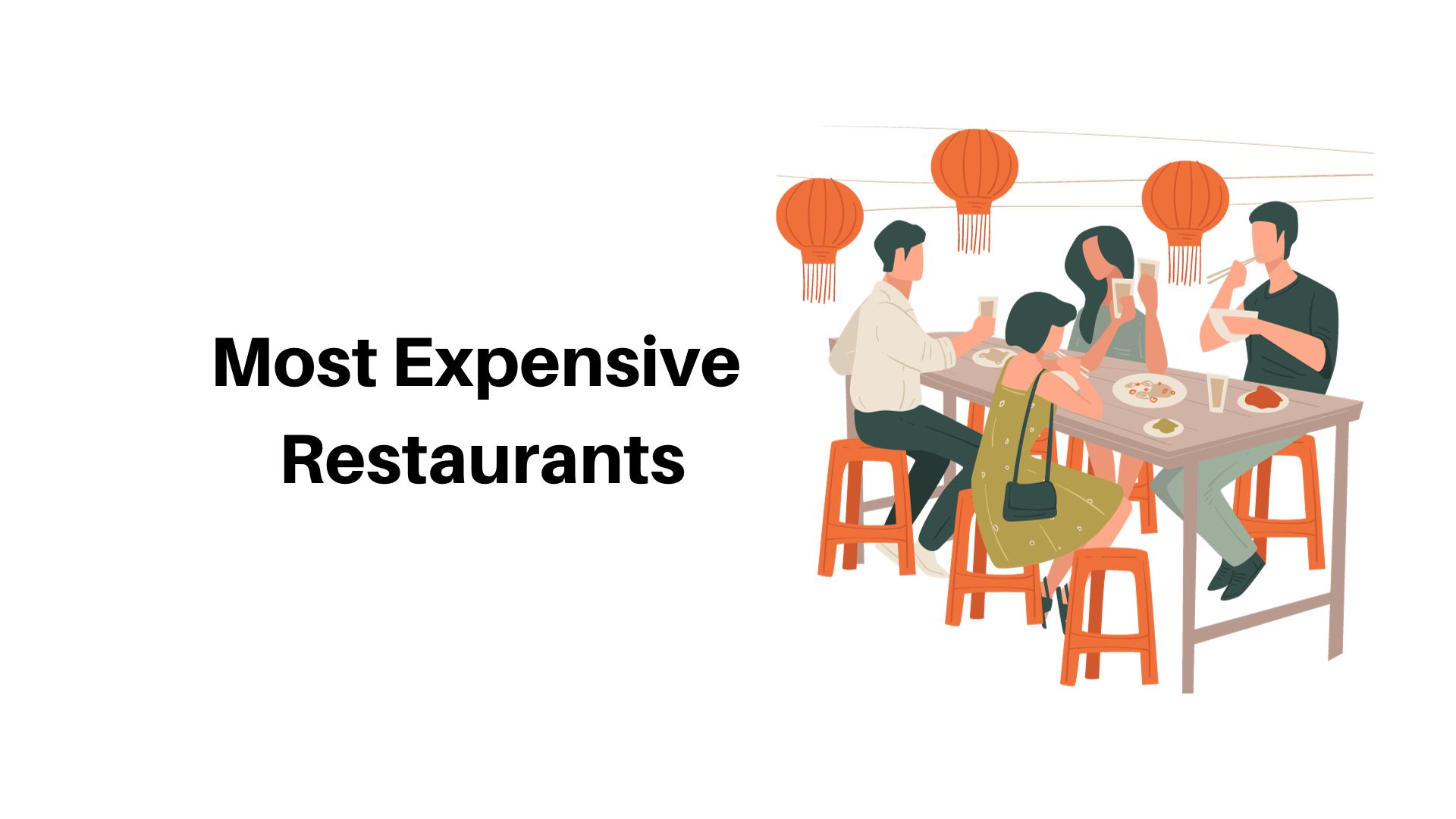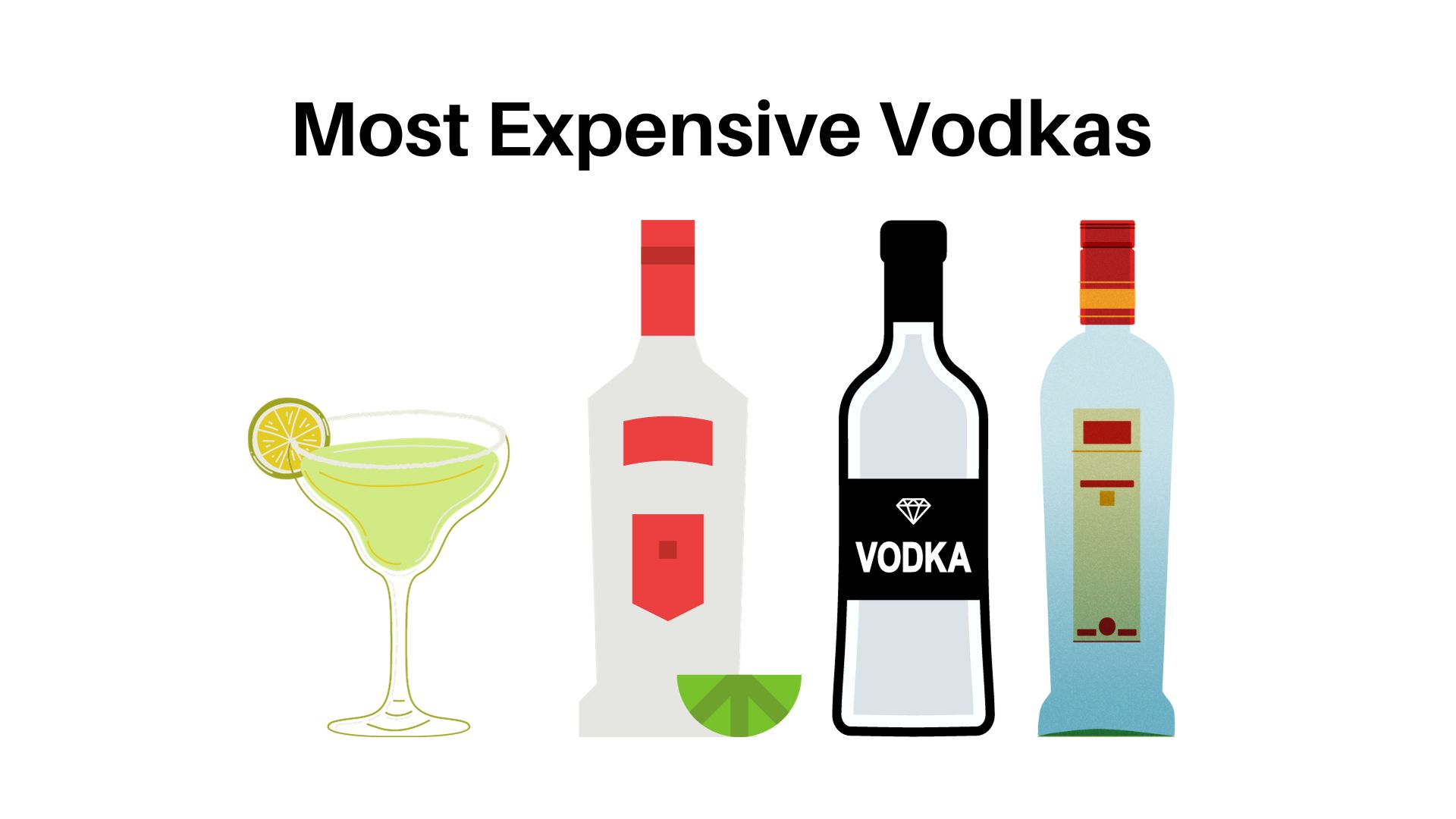Top 10 Most Expensive Foods in the World
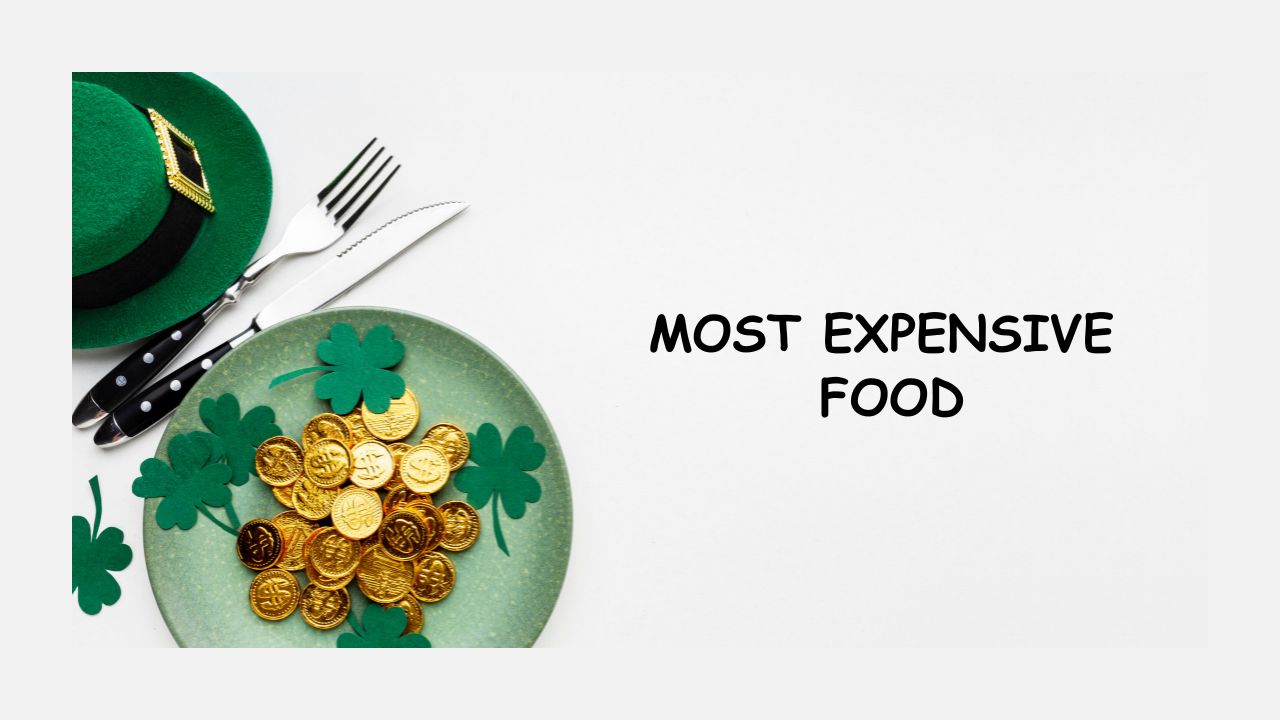
Page Contents
Food is an integral component of life. Not only does it provide sustenance for survival and nourishment; but it can also serve as entertainment, cultural identity expression, and interpersonal bonding opportunities. Food provides essential elements that the body requires for optimal performance, such as vitamins, minerals; proteins; fats, and carbohydrates. There is an abundance of food options available worldwide as different cultures and cuisines have their own culinary traditions and ingredients. Food production and consumption should be conducted in an eco-friendly manner to protect both environment and health; otherwise, they could have devastating repercussions for both. Therefore, eating habits have gained increased prominence among individuals, communities, and politicians.
History of Food:
At the dawn of human civilization, people needed to hunt, gather, and plant food in order to survive. Before agriculture emerged around 10,000 years ago, early people subsisted on diets rich in meats, fish, fruits, and vegetables.
Domesticating plants and animals enabled humans to produce more food than they required immediately for consumption, leading to the establishment of societies. With so much food on hand, trade, labor specialization, city expansion, and trade were all made possible due to this abundance of sustenance. Furthermore, food has long been associated with social status and cultural identity: for instance, the Pharaohs of Ancient Egypt were well known for their lavish feasts featuring exotic cuisine from across their empire while medieval Europe's upper class feasted lavishly while poorer classes consumed less extravagant fare.
Food supplies around the world were dramatically expanded when crops like potatoes, tomatoes, and maize from New World were first brought back into Europe and Asia during the 15th and 16th centuries following the discovery of America. This process became known as Columbian Exchange which involved sharing agricultural knowledge between the Old and New Worlds.
Technology and transportation developments of the 19th and 20th centuries enabled mass production and distribution of food. Due to industrial agriculture's use of synthetic pesticides and fertilizers, local food production became part of an international enterprise.
Concerns over industrial agriculture have spurred an interest in more sustainable and local food systems. Individuals now prefer organic locally produced food options to support small-scale farmers while lessening carbon impact and encouraging healthy eating habits – which makes food history all the more relevant. It represents our complex relationship to our surroundings as well as all forms of cultural influence which impact eating patterns – all depicted through food history.
Classification of Foods:
- Food can be classified based on its key nutrients such as carbohydrates, proteins, fats, vitamins, and minerals that it provides. For example, protein-rich foods include meats such as meat and beans while carbohydrate-rich items include bread such as pasta and rice.
- Food is organized into five broad categories by the United States Department of Agriculture (USDA), such as fruits, vegetables, grains, protein foods, and dairy. This classification helps individuals build balanced and healthy diets.
- Based on its cuisine (i.e. Italian, Mexican, or Chinese) food can be classified. Furthermore, meals may also be divided up based on when they're most often eaten during the day: breakfast, lunch dinner, or snacks.
- Foods can be classified according to how they're prepared: fried, baked, grilled, or steamed. manca Additionally, specific dietary needs such as Kosher, Vegan, or Gluten-Free status could determine their classification.
- Food can also be divided by its flavor profile; such as sweet, savory, sour, or spicy.
Sources of Food:
- Foods derived from plants include fruits, vegetables, grains, nuts, and seeds – these typically provide plenty of fiber, vitamins, and other vital nutrients to our diets.
- Meat, fish, eggs, and dairy are important sources of nutrition, offering protein, iron, and vitamin B12. Certain edible fungi (like mushrooms ) can also serve as sources of these essential elements.
- Numerous tribes around the world consume insects as food, providing an ample supply of protein, vitamins, and minerals. Spirulina and chlorella algae can also serve as sources of such benefits.
- Innovative food technologies now make possible the production of synthetically manufactured foods such as lab-grown beef or plant-based alternatives to meat.
- Foods produced for processing such as packaged snacks; baked goods and convenience dinners may contain sugar or salt additives while beverages like juice, water; tea, or coffee offer essential nutrition and hydration benefits as well.
Health Benefits of Food:
- Maintain a healthy weight and lower the risk of obesity by choosing a diet rich in fruits, vegetables, whole grains, lean proteins, and healthy fats – this will also lower the chances of chronic illnesses like diabetes, heart disease, and stroke.
- Consuming high-fiber meals like fruits, vegetables, and whole grains is proven to improve digestive health while decreasing constipation risks and other digestive disorders.
- Eating a diet rich in vitamins, minerals, and other necessary nutrients can strengthen immunity while decreasing infection risks and diseases.
- B vitamins and omega-3 fatty acids; are two nutrients essential to brain functioning that can enhance mood and cognitive performance; as well as encourage good aging while; decreasing risks related to age-related illnesses such as Alzheimer's and osteoporosis.
- Food provides us with essential nutrients such as carbohydrates; proteins; lipids; vitamins, and minerals essential to proper body functioning and development; especially during childhood and adolescence.
- Proper nutrition plays a pivotal role in supporting our bodies' immunity to diseases and infections; helping strengthen their defense mechanisms against illness. To remain healthy and stay free of illness and infection, regular use of proper nutrition must be implemented into one's lifestyle.
The Popularity of Food
Numerous elements, including customs from different cultures, accessibility, pricing, and current food industry trends can impact how popular cuisine is. While certain dishes may be loved worldwide, others might only be enjoyed locally or by certain civilizations.
Fast food and packaged snacks have seen rapid popularity due to their cost and convenience; yet as individuals become more aware of the health advantages associated with eating whole foods and limiting processed and artificial substances in their diets, so there has also been an upsurge in interest for healthy organic meals.
Social media has had an immense effect on food's popularity, where numerous food bloggers and influencers post recipes and recommendations that contribute to an explosion in cuisines, eateries, and food trends such as avocado toast, smoothie bowls, and plant-based diets.
Food's appeal can fluctuate over time due to changes in cultural standards, health concerns, economic factors, and more.
Cultural Significance:
- Food and cultural identity are frequently intertwined, with particular cuisines or cooking methods associated with certain geographical or racial groups. For instance, sushi and ramen are typically associated with Japan while pasta and pizza are classic Italian dishes.
- Cultural festivals and traditions such as weddings, funerals, and holidays often involve food. Dishes that have been passed down through generations may hold significant historical and cultural significance.
- Food can create or strengthen social bonds within any community, providing an avenue for exchanging values, customs, and stories between members. Sharing meals together promotes a sense of togetherness while offering an avenue to exchange values, customs, and histories among diners.
- Different cuisines employ various combinations of ingredients, spices, and cooking methods to produce distinct tastes and sensations that serve to define their culinary tradition. Food may serve as an expressive representation of cultural values.
- Maintaining health and well-being could benefit greatly from adhering to traditional diets and cooking methods, such as the Mediterranean Diet which emphasizes fresh fruit, vegetables, whole grains, and healthy fats – proven to lower heart disease risk as well as other chronic illnesses.
- Food cultures and cuisines around the world have become more interconnected over time, as people migrate, travel, and share their experiences online – taking with them their food traditions along with them as well as introducing others to new ones.
Why Foods Are Expensive?
- Due to low supply and high demand, certain foods may only be available during certain seasons or locations, which could increase their price. For instance, seasonal fruits and vegetables might cost more when not readily accessible at certain periods during the year; and food grown exclusively in certain locations or nations may add significant transportation costs and increase final prices accordingly.
- Food manufacturing costs vary considerably based on the nature and production techniques employed, including organic or specialty crops requiring extra work or resources that drive up their cost, free-range eggs or grass-fed cattle products being among those that typically incur greater production expenses, etc.
- Long-distance transportation costs and equipment needs can increase food costs that need special handling or storage conditions, for instance with refrigerated vehicles and storage facilities that must keep items frozen or chilled during delivery becoming more costly.
- Businesses often spend significant funds branding and marketing their goods, which can increase the price of finished products. Premium brands may charge additional prices due to their distinctiveness or superior reputation.
- Food costs can also be affected by economic variables like inflation, currency changes, and supply chain interruptions. A drought or natural disaster might reduce crop output and raise food prices; variations in currency rates could alter imported foods' cost to customers.
- Tariffs and subsidies are two types of government policies that can have an effect on food costs. Subsidies could make specific crops less costly while tariffs might drive up their cost.
Mentioned Below Are The World’s Top 10 Most Expensive Foods
- CAVIER – WORTH $34,500
- WAGYU BEEF – WORTH $30,000
- SAFFRON – WORTH $10,000
- WHITE TRUFFLE – WORTH $10,000
- ELVISH HONEY – WORTH $6,000
- BLUEFISH TUNA – WORTH $5,000
- IBERICO HAM – WORTH $3,846
- KOPI LUWAK COFFEE – WORTH $700/KG
- OYSTERS – WORTH $100/DOZEN
- FOIE GRAS – WORTH $31-35
#1. CAVIAR – WORTH $34,500
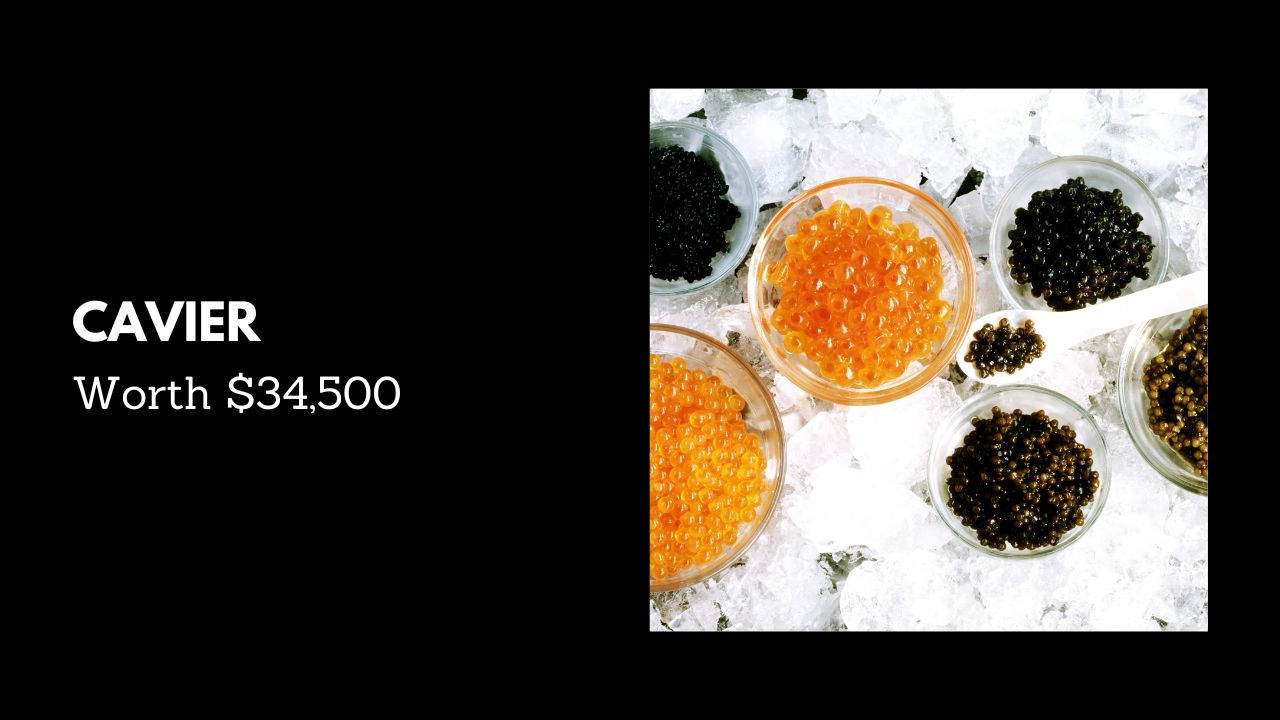
Single salted sturgeon roe or fish eggs; are among the most expensive delicacies. Caviar from beluga sturgeons, osetra, and sevruga is particularly esteemed, while beluga caviar from an Iranian rare beluga Sturgeon now holds the Guinness World Record and costs USD 34,500 per kg! Global News Wire estimates total caviar market value to reach USD 304.9 Million by 2020 with expected 8.3% compound annual compound growth between 2021-2027 totaling USD 530 Million by 2027! Traditional caviar comes mainly from Caspian Sea commercial fishers while Siberia; China; and North America also possess species ideal for caviar production.
#2. WAGYU BEEF – WORTH $30,000
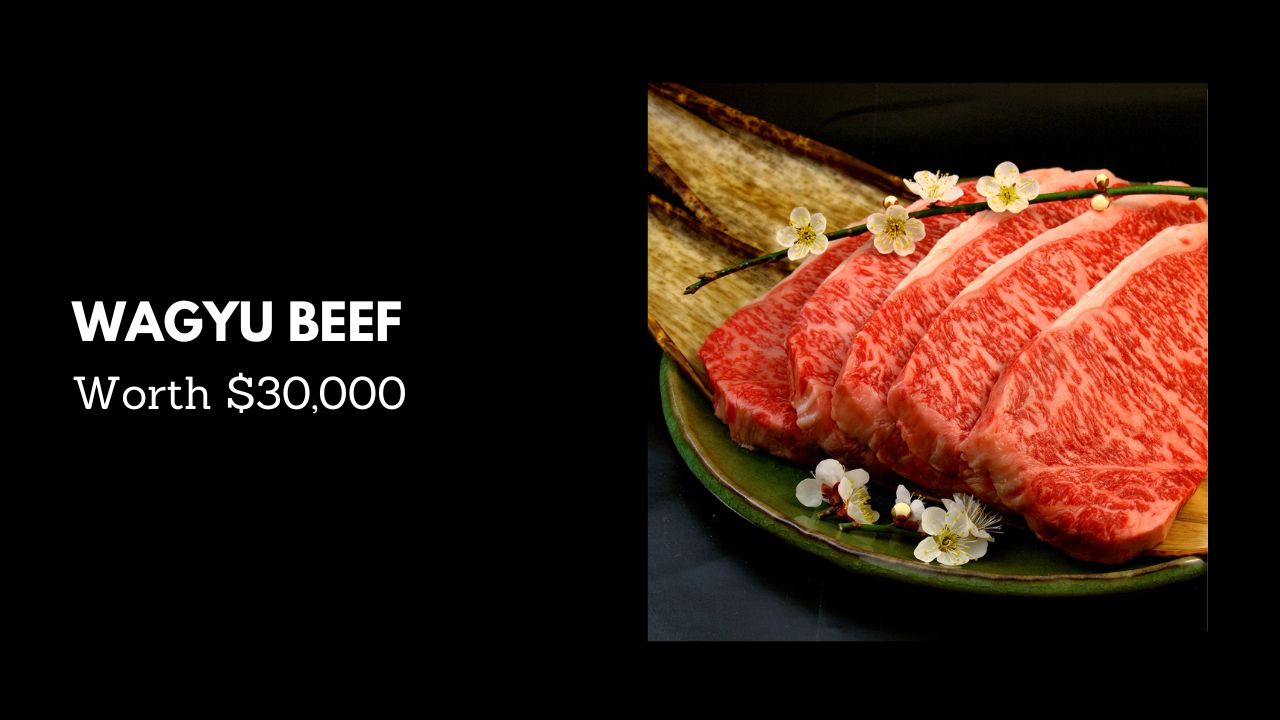
Wagyu meat; derives its name from its Japanese namesake: Wagyu cows. With juicy; soft and flavorful meat that boasts premium price tags of USD 30,000 (0.45 kg); each cow producing Wagyu meat fetches nearly USD 30,000 at auction according to Business Insider India.
Wagyu beef is produced from cows bred specifically to develop physical toughness; leading to their intramuscular fat cells expanding more uniformly throughout their muscles and producing the signature pink color and delicate flavor that makes Wagyu so desirable.
Olive Wagyu steaks are known to sell between USD 120 to USD 300 per steak.
#3. SAFFRON – WORTH $10,000
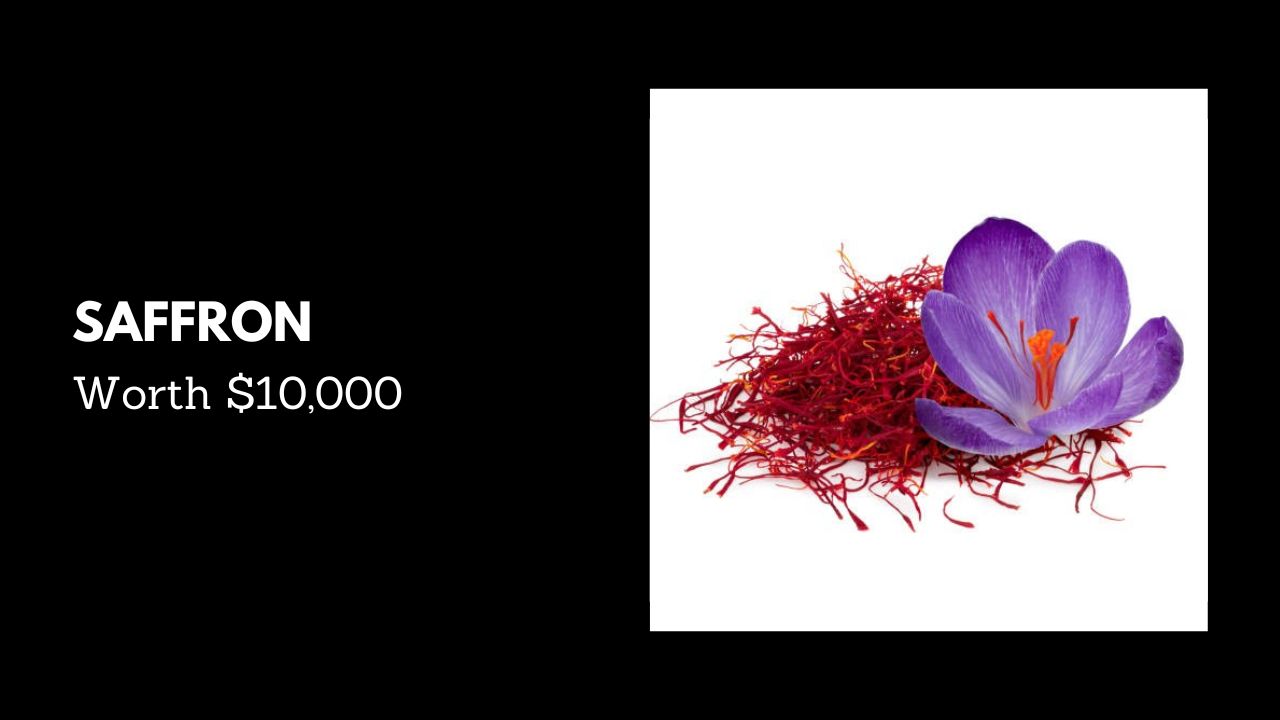
Saffron is one of the world's most luxurious delicacies, and producing one pound (0.45 kg) requires using 75,000 flowers from Crocus sativus (also known as Saffron crocus), an Iris family flower known as Crocus Sativus or Saffron Crocus which produces three orange-yellow stigmas on each bloom to produce its threads – Iran, Greece, Spain, and India are among its main growing regions for production with nearly 90% coming from Iran alone; costs per gram range between USD 7-15 with premium varieties like Kashmir producing premium quality offering over USD 1,500 per pound (0.45 kg).
#4. WHITE TRUFFLE – WORTH $10,000
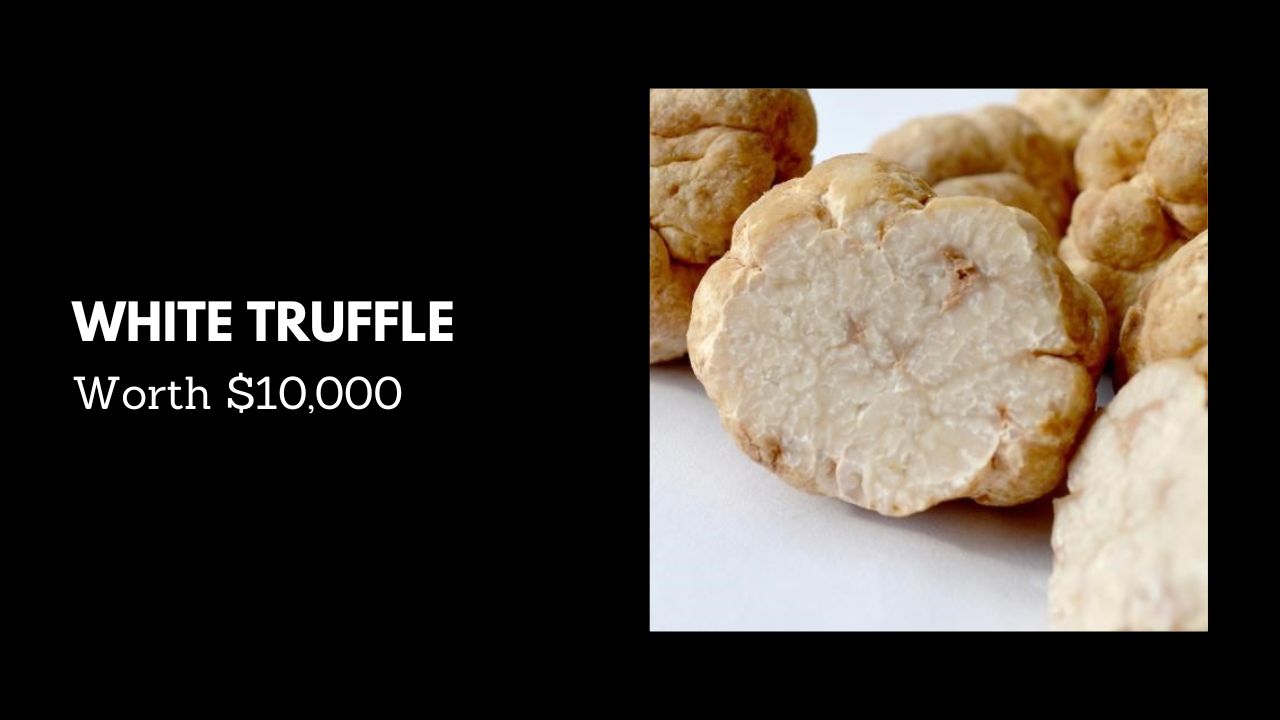
Northern Italy's Piedmont region, Western Italy's Emilia-Romagna area, the Marches region, and Croatia's Istrian peninsula are all frequent locations for white truffles. Only trained canines can detect their scent which grows about one foot underground – making this delicacy famous for its distinctive flavor and scent.
White truffle (Tuber magnatum pico), one of the world's most costly foods and edible fungus species, can cost as much as USD 10,000 per kilogram, according to Guinness World Records.
Two pounds (907.1 grams) of this yellowish, potato-like mushroom were sold at auction during the International Alba White Truffle Fair in Piedmont for nearly USD 118,000 in 2021 at Castle of Grinzane Cavour.
#5. ELVISH HONEY – WORTH $6,000

At USD 5,330 per kilogram, Elvish honey commands an extraordinary price tag. Its delicate taste and exquisite aroma are reason enough, while its price tag can be explained by its source – a 1,800-metre-deep cave in Artvin, Turkey where minerals contribute to its exquisite flavor. According to Ecocolmena, Elvish honey's remarkable price may also stem from its production process without using beehives or beekeepers: bees simply collect pollen from wildflowers surrounding Artvin, then transform it into liquid gold through processing within another cave!
#6. BLUEFISH TUNA – WORTH $5,000
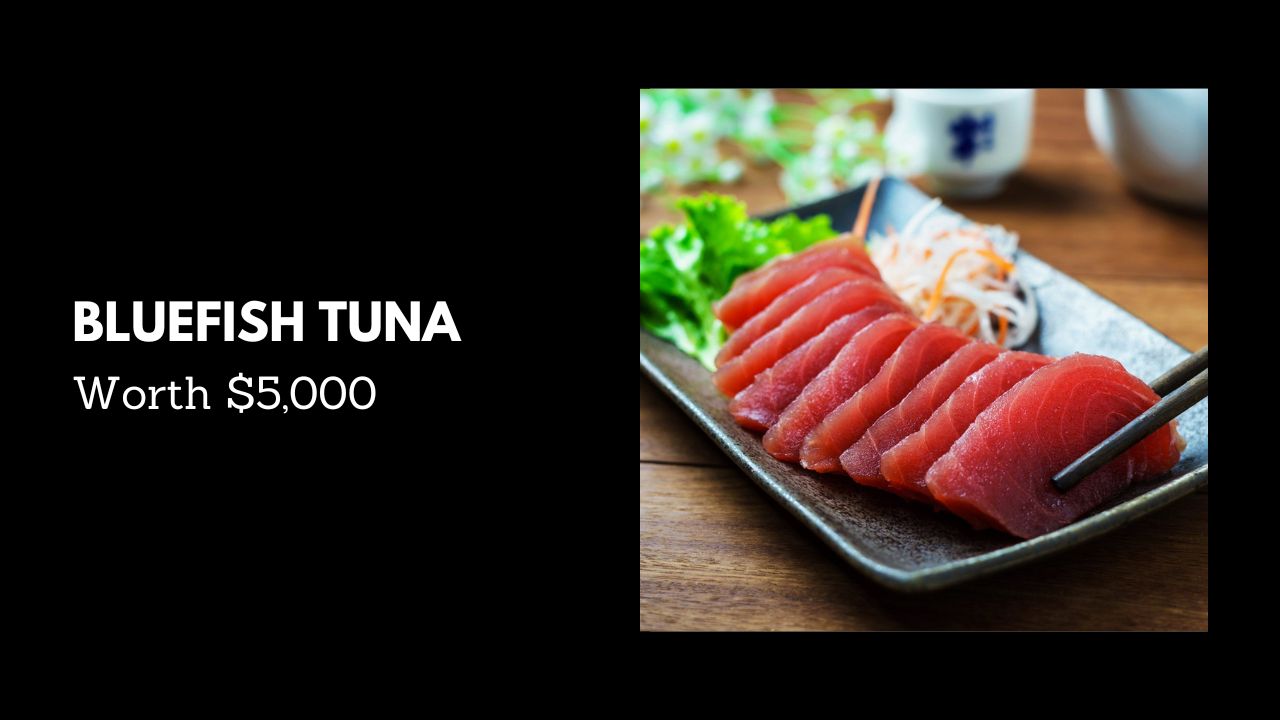
Due to its limited supply, bluefin tuna is one of the world's most coveted kinds of seafood and the most costly food. According to Worldwildlife, overfishing of Atlantic, Pacific, and Southern bluefin tuna populations has been driven mainly by demand in sushi markets; consequently their populations have seen a significant decrease.
Bluefin tuna prices depend on its type and region; however, at a recent auction in Japan the per-kg cost soared to USD 5,000 according to The Japan Times; one 212kg Bluefin tuna sold for an astounding USD 273,000 at Toyosu fish market during their New Year's auction in Tokyo.
#7. IBERICO HAM – WORTH $3,846

Iberian Ham (Jamon Iberico); beloved among foodies worldwide; is an indulgence worth dreaming about. Produced in Portugal or Spain from rear-leg black pigs raised for two years prior to curing for three to 36 months in Spain or Portugal respectively. According to Guinness World Records a leg of Jamon Iberico de Bellota — considered by most experts as being of the highest quality — costs USD 3,843.1 when sold by Taishi Co. Ltd in Japan; Iberico Bellota has an extended curing process which involves rearing for two years prior to curing for three more years before curing of all legs is completed.
#8. KOPI LUWAK COFFEE – WORTH $700/KG

Did you know that Kopi Luwak coffee is produced using beans consumed, digested, and expelled from cats living in the Indonesian province of Irian Jaya? In particular, Sumatran Civet Cats produce Kopi Luwak's pungent yet earthy taste through natural means; climbing trees to grab as many coffee cherries as they can before dropping their excrement on locals for collection by local authorities. According to Guinness World Records, this most expensive variety can sell for USD 700 per pound (0.45 kg), and only 500 lbs (227kg are produced annually – making Kopi Luwak the world's most expensive coffee option ever seen on Earth!
#9. OYSTERS- WORTH $100/DOZEN
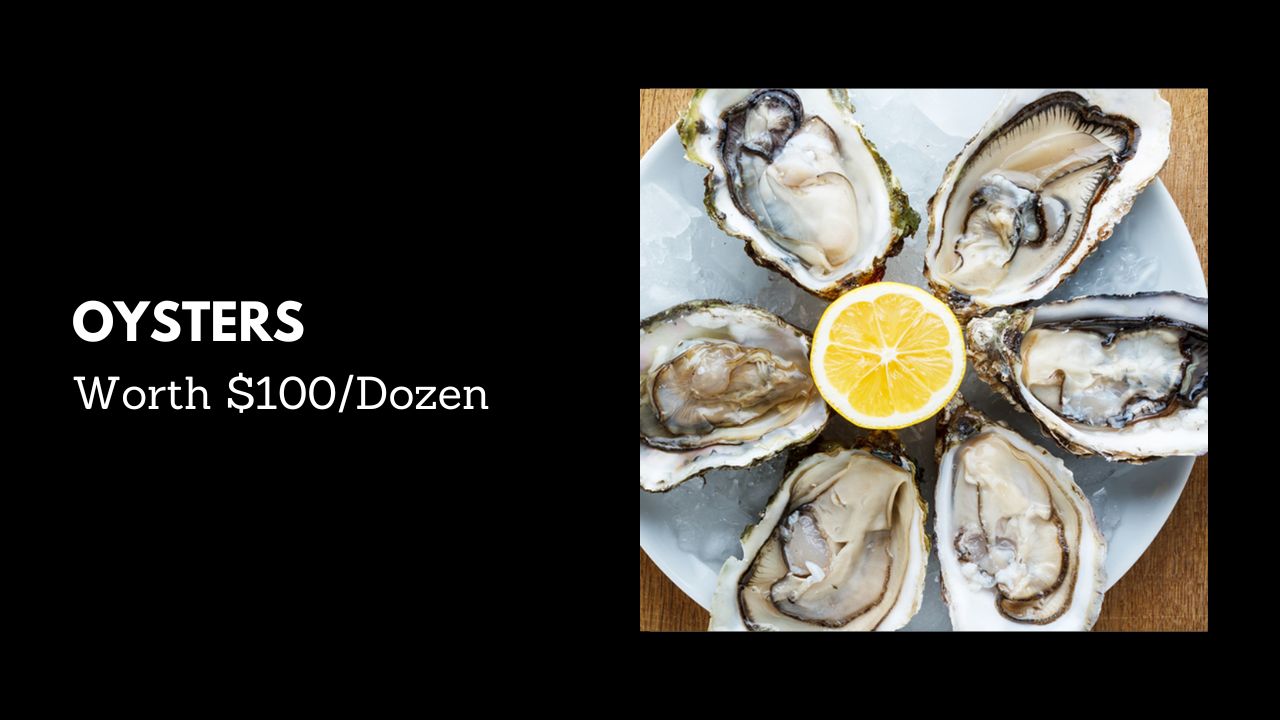
Oysters are commonly found along US coasts in brackish water environments. Coffin Bay King Oysters are among the world's most expensive foods while Bluff Oysters are widely considered one of the world's delectable cuisines; these mollusks take approximately seven years to mature fully and become edible.
Due to an oyster shortage and increased demand in the US, processors were forced to pay up to USD 70 per sack at docks according to a WAFB story from 2022. Oyster varieties vary with regard to saltiness; US eastern oysters tend to be saltier while Pacific ones suit those with more sophisticated palates better.
#10. FOIE GRAS- WORTH $31-35
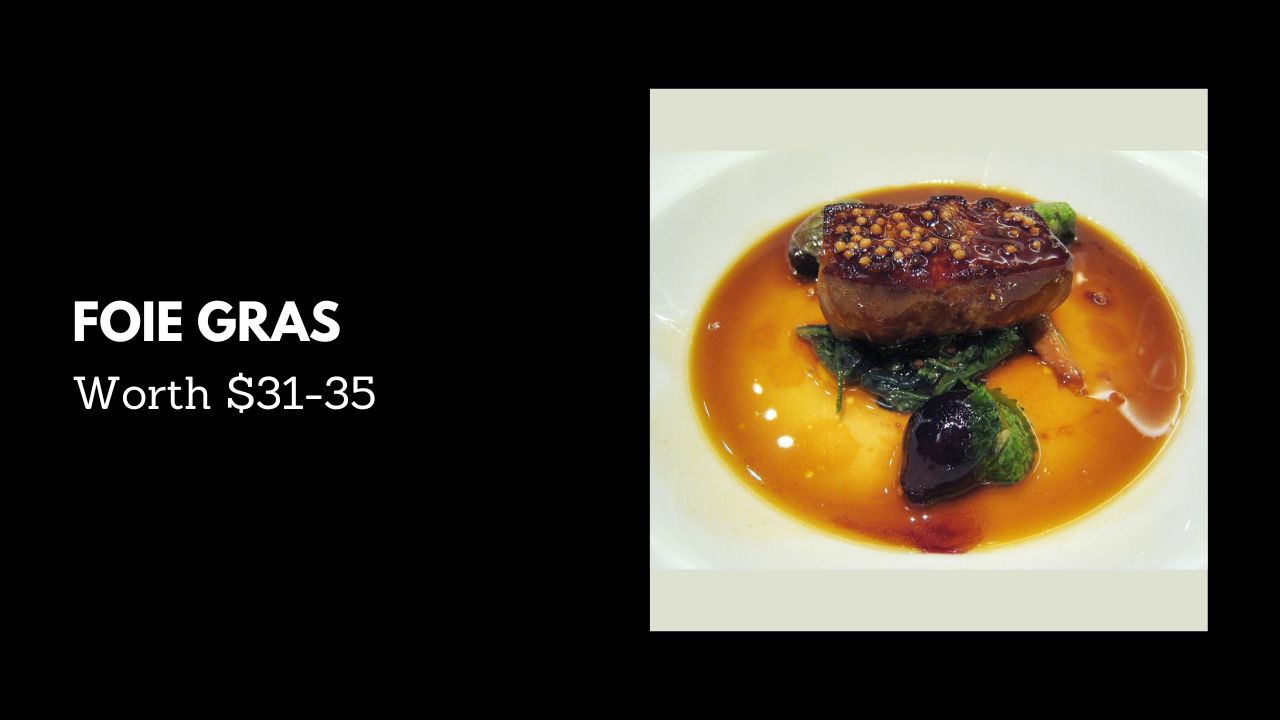
Foie gras, commonly referred to as fatty liver, is one of the most expensive and well-liked dishes in French cuisine. Constructed using either duck or goose livers, one kilogram typically sells for US$31-39 on the market.
Due to the use of feeding tubes to force-feed geese and ducks maize to increase fat content during production, foie gras production is both uncommon and prohibited in most nations; according to Britannica however, food production could possibly take place in Strasbourg province.
Foie gras delicacies, often eaten as pastries or Pate de foie gras, feature baked crusts with jelly lines. Truffles and seasonings may also be added during preparation; serving options may range from hot to cold depending on one's personal taste
Bottom line:
Food is vital to our physical survival and cultural tradition. Eating healthily with a varied, well-rounded diet offers numerous health advantages that contribute to greater well-being.
Recent years have witnessed increased criticism of the food industry due to the use of toxic chemicals and additives during processing, the environmental impacts of production, and fast food and processed snack consumption, all leading to public health risks. Consumers are becoming more aware of these issues, hence an upswing in interest in plant-based diets, organic local produce, and sustainable production techniques as more consumers become educated on them. We can work towards creating an equitable world where everyone has access to nutritious, culturally appropriate meals that support both personal and planetary well-being if we advocate for healthy and sustainable food practices!
FAQ.
Italy was named number one on a global ranking of most-recognized cuisines worldwide in 2022, followed by Greece and Spain.
Norway, Sweden and Denmark's cultures were inspirations for creating the Nordic Diet which emphasizes protein and fibre intake through fish, berries, whole grain cereals, low-fat dairy goods, root vegetables and rapeseed oil as main components.
Thailand. Renowned for its delicious street food, Thailand also boasts one of the world's most tantalizing cuisines - CNN even awarded Bangkok as having one of the greatest street cuisine scenes globally!
With its abundance of hot spices, Andhra Pradesh is commonly referred to as India's version of Mexico. These spicy levels apply to all rice-based dishes there and we appreciate its regal heritage - red-hot meals come from Nawabi culture's influence over local culinary tastes.

Aditi is an Industry Analyst at Enterprise Apps Today and specializes in statistical analysis, survey research and content writing services. She currently writes articles related to the "most expensive" category.

